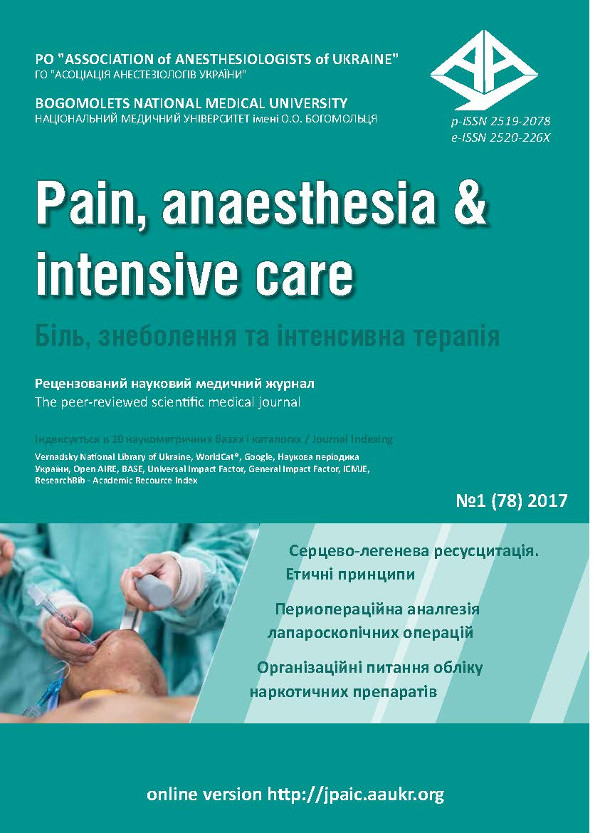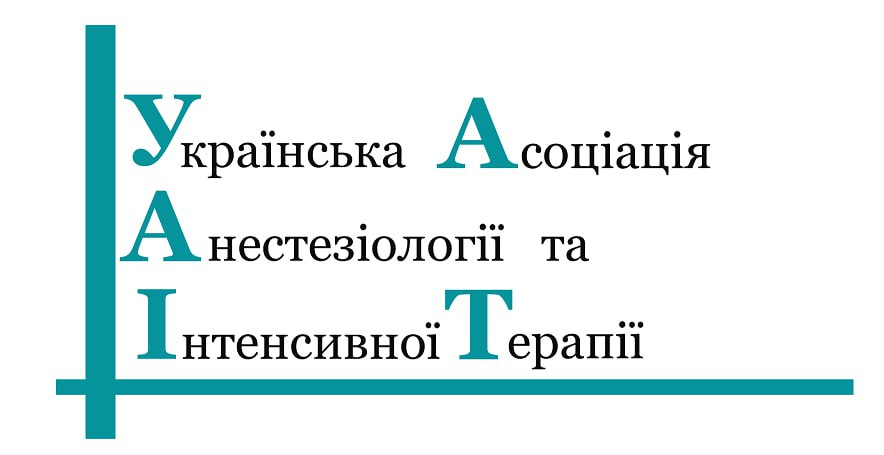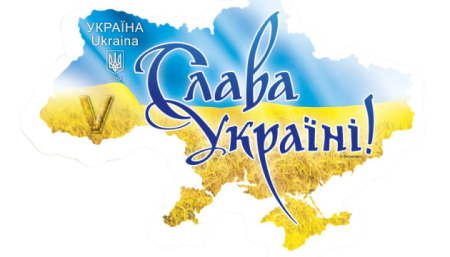Застосування свіжої цільної крові для ресусцитації при масивній крововтраті
DOI:
https://doi.org/10.25284/2519-2078.1(78).2017.103024Ключові слова:
кровотеча, масивні гемотрансфузії, свіжа цільна кров, кoмпоненти крові, індукована травмою коагулопатіяАнотація
Свіжа цільна кров почала використовуватися для лікування кровотеч більше ніж 100 років тому. Однак потім поширилася практика застосування компонентної терапії препаратами крові – це консервовані еритроцити, свіжозаморожена плазма, тромбоцити, кріопреципитат. Однією з головних проблем при масивних гемотрансфузіях є індукована травмою коагулопатія. З метою її профілактики та лікування при масивних гемотрансфузіях останнім часом рекомендують використовувати компоненти крові у співвідношенні еритроцити:СЗП:тромбоцити – 1:1:1. Але, по-перше, це далеко не завжди мо жливо внаслідок дефіциту компонентів крові, і, крім того, такі співвідношення наближаються до тих, які вже існують в цільній крові. Останнім часом, поширюється думка, що перехід на компонентну терапію далеко не завжди себе виправдовує, а свіжа цільна кров набагато ефективніша, ніж компонентна терапія для лікування індукованої травмою коагулопатії. Показання до застосування, переваги и недоліки свіжої цільної крові являються темою цього огляду.Посилання
Kauvar DS, Lefering R, Wade CE. Impact of hemorrhage on trauma outcome: an overview of epidemiology, clinical presentations, and therapeutic considerations. J Trauma. 2006; 60(6):S3-S11. https://doi.org/10.1097/01.ta.0000199961.02677.19
 |
|  |
| 
American Red Cross. [Accessed September 3, 2012] Blood Facts and Statistics. 2006. http://www.redcrossblood.org/learn-about-blood/blood-facts-and-statistics ― blood-components. United States Department of Health and Human Services. The 2009 National Blood Collection and Utilization Survey Report. 2009.
Whitaker, BI.; Hinkins, S. The 2011 National Blood Collection and Utilization Survey Report. U.S. Department of Health and Human Services; 2011.
Department of Defense. Fresh Whole Blood (FWB) Transfusion. San Antonio, TX: Joint Trauma System; 2012:1-44.
Goforth CW., Tranberg JW., Boyer P, Silvestri PJ. Fresh Whole Blood Transfusion: Military and Civilian Implications. Critical Care Nurse. 2016; 36[3]: 50-57. https://doi.org/10.4037/ccn2016780
 |
|  |
| 
Erber WN. Massive blood transfusion in the elective surgical setting. Transfusion Apheresis Science. 2002; 27:83–92. https://doi.org/10.1016/s1473-0502(02)00029-0
 |
|  |
| 
Malone DL, Hess JR, Fingerhut A. Massive transfusion practices around the globe and a suggestion for a common massive transfusion protocol. J Trauma. 2006;60(6 Suppl):91–6. https://doi.org/10.1097/01.ta.0000199549.80731.e6
 |
|  |
| 
Croce, M., Tolley, E.. Transfusions result in pulmonary morbidity and death after a moderate degree of injury. J Trauma. 2005; 59:19-24. https://doi.org/10.1097/01.ta.0000171459.21450.dc
 |
|  |
| 
Hakala P, Hiippala S, et al. Massive blood transfusion exceeding 50 units of plasma poor red cells or whole blood: the survival rate and the occurrence of leukopenia and acidosis. Injury. 1999;30:619–622. https://doi.org/10.1016/s0020-1383(99)00166-7
 |
|  |
| 
Alam HB, Stanton K, et al. Effect of different resuscitation strategies on neutrophil activation in a swine model of hemorrhagic shock. Resuscitation. 2004; 60:91–99. https://doi.org/10.1016/j.resuscitation.2003.08.006
 |
|  |
| 
Holcomb JB. Methods for improved hemorrhage control. Critical Care. 2004; 8(Suppl):S57–S60. https://doi.org/10.1186/cc2407
 |
|  |
| 
McMullin NR, Holcomb JB, et al. (2006). Hemostatic resuscitation. In Vincent JL (Ed). Yearbook of Intensive Care and Emergency Medicine. New York, NY, Springer, 2006, p. 265-278. https://doi.org/10.1007/3-540-33396-7_25

Manno CS, Hedberg KW, et al. Comparison of the hemostatic effects of fresh whole blood, stored whole blood, and components after open heart surgery in children. Blood. 1991; 77:930–936.
 |
|  |
| 
Kauvar DS, Holcomb JB, et al. Fresh whole blood transfusion: A controversial military practice. J Trauma. 2006; 61:181–184. https://doi.org/10.1097/01.ta.0000222671.84335.64
 |
|  |
| 
Sondeen JL, Wade CE, et al. Fresh whole blood is the best 24-hour hypotensive resuscitative fluid in severe hemorrhage in swine. Shock. 2006; 25(6):21. https://doi.org/10.1097/00024382-200606001-00064

Grosso SM, Keenan JO. Whole blood transfusion for exsanguinating coagulopathy in a U.S. field surgical hospital in postwar Kosovo. J Trauma. 2000; 49:145–148. https://doi.org/10.1097/00005373-200007000-00022
 |
|  |
| 
Hughes J, Macdonald V, Hess J. Warm storage of whole blood for 72 hours. Transfusion. 2007;47(11):2050-2056. https://doi.org/10.1111/j.1537-2995.2007.01429.x
 |
|  |
| 
Repine TB, Perkins JG, Kauvar DS, Blackborne L. The use of fresh whole blood in massive transfusion. J Trauma. 2006;60(6):S59-S69. https://doi.org/10.1097/01.ta.0000219013.64168.b2
 |
|  |
| 
Ho AM-H, Karmakar MK, Dion PW. Are we giving enough coagulation factors during major trauma resuscitation? Am J Surg. 2005;190(3):479-484. https://doi.org/10.1016/j.amjsurg.2005.03.034
 |
|  |
| 
Spinella PC, Perkins JG, Grathwohl KW, et al. Risks associated with fresh whole blood and red blood cell transfusions in a combat support hospital. Crit Care Med. 2007;35(11):2576-2581. https://doi.org/10.1097/01.ccm.0000285996.65226.a9
 |
|  |
| 
Spinella PC, Perkins JG, Grathwohl KW, Beekley AC, Holcomb JB. Warm fresh whole blood is independently associated with improved survival for patients with combat-related traumatic injuries. J Trauma. 2009;66(4 suppl):S69. https://doi.org/10.1097/ta.0b013e31819d85fb
 |
|  |
| 
Kaufman R. A fresh take on whole blood. Transfusion. 2011; 51:230–3. https://doi.org/10.1111/j.1537-2995.2010.02949.x
 |
| 
Brohi K, Singh J, et al. Acute traumatic coagulopathy. J Trauma. 2003;54:1127-1130. https://doi.org/10.1097/01.ta.0000069184.82147.06
 |
| 
Borgman MA, Spinella PC, et al. The ratio of blood products transfused affects mortality in patients receiving massive transfusions at a combat support hospital. J Trauma. 2007; 63(4):805-13. https://doi.org/10.1097/ta.0b013e3181271ba3
 |
| 
Kaufmann CR, Dwyer KM, et al. Usefulness of thrombelastography in assessment of trauma patient coagulation. J Trauma. 1997; 42:716–72. https://doi.org/10.1097/00005373-199704000-00023
 |
| 
Niles SE, McLaughlin DF, et al. Increased mortality associated with the early coagulopathy of trauma in combat casualties. J Trauma. 2008;64:1459–1465. https://doi.org/10.1097/ta.0b013e318174e8bc
 |
| 
Hess J, Holcomb J, et al. Damage control resuscitation: the need for specific blood products to treat the coagulopathy of trauma. Transfusion. 2006; 46:685-686. https://doi.org/10.1111/j.1537-2995.2006.00816.x
 |
| 
Frith D, Goslings JC, Gaarder C, Maegele M, Cohen MJ, Allard S, et al. Definition and drivers of acute traumatic coagulopathy: clinical and experimental investigations. J Thromb Haemost. 2010; 8(9):1919–25. https://doi.org/10.1111/j.1538-7836.2010.03945.x
 |
| 
Maegele M, Lefering R, Yucel N, Tjardes T, Rixen D, Paffrath T, et al. Early coagulopathy in multiple injury: an analysis from the German Trauma Registry on 8724 patients. Injury. 2007; 38(3):298–304. https://doi.org/10.1016/j.injury.2006.10.003
 |
| 
MacLeod JB, Lynn M, McKenney MG, Cohn SM, Murtha M. Early coagulopathy predicts mortality in trauma. J Trauma. 2003; 55(1):39–44. https://doi.org/10.1097/01.ta.0000075338.21177.ef
 |
| 
Moore EE, Knudson MM, Jurkovich GJ, Fildes JJ, Meredith JW. Emergency traumatologist or trauma and acute care surgeon: decision time. J Am Coll Surg. 2009;209(3):394–5. https://doi.org/10.1016/j.jamcollsurg.2009.06.003
 |
| 
Cap A, Hunt BJ. The pathogenesis of traumatic coagulopathy. Anaesthesia.2015;70 Suppl 1:96–101. e32–4. https://doi.org/10.1111/anae.12914
 |
| 
The European guideline on management of major bleeding and coagulopathy following trauma: fourth edition. Rossaint R, Bouillon B, Cerny V, Coats T., Duranteau J, Fernandez-Mondejar E, Filipescu D, Hunt BJ, Komadina R, Nardi G, Neugebauer EAM, Ozier Y, Riddez L, Schultz A, Vincent J-L, Spahn DR. Critical Care. 2016; 20:100. https://doi.org/10.1186/s13054-016-1265-x
 |
| 
Kutcher ME, Kornblith LZ, Narayan R, et al. A paradigm shift in trauma resuscitation: evaluation of evolving massive transfusion practices. JAMA Surg. 2013 Sep;148(9):834-40. https://doi.org/10.1001/jamasurg.2013.2911
 |
| 
Holcomb JB, Jenkins D, Rhee P, et al. Damage control resuscitation: directly addressing the early coagulopathy of trauma. J Trauma. 2007; 62(2): 307-310. https://doi.org/10.1097/ta.0b013e3180324124
 |
| 
Holcomb JB, Zarzabal LA, Michalek JE, et al. Increased platelet: RBC ratios are associated with improved survival after massive transfusion. J Trauma.2011;71(2):S318-S328. https://doi.org/10.1097/ta.0b013e318227edbb
 |
| 
Holcomb JB. Optimal use of blood products in severely injured trauma patients. Hematology Am Soc Hematol Educ Program. 2010; 2010:465–469. https://doi.org/10.1182/asheducation-2010.1.465
 |
| 
Strandenes G, De Pasquale M, Cap AP, Hervig TA, Kristoffersen EK, Hickey M, Cordova C, Berseus O, Eliassen HS, Fisher L, Williams S, Spinella PC. Emergency whole-blood use in the field: a simplified protocol for collection and transfusion. Shock. 2014 May; 41 Suppl 1:76-83. https://doi.org/10.1097/shk.0000000000000114
 |
| 
Bowling F, Pennardt A. The use of fresh whole blood transfusions by the SOF medic for hemostatic resuscitation in the austere environment. J Spec Oper Med. 2010;10:25-35.
 |
| 
Johnston TD, Chen Y, Reed R L. Functional equivalence of hypothermia to specific clotting factor deficiencies. J Trauma. 1994; 37:413–417. https://doi.org/10.1097/00005373-199409000-00014
 |
| 
Patt A, McCroskey B L, Moore EE. Hypothermia-induced coagulopathies in trauma. Surgical Clinics of North America. 1988; 68:775–785. https://doi.org/10.1016/s0039-6109(16)44585-8
 |
| 
Steiner ME, Assmann SF, Levy JH, Marshall J, Pulkrabek S, Sloan SR, et al. Addressing the question of the effect of RBC storage on clinical outcomes: the Red Cell Storage Duration Study (RECESS) (Section 7). Transfus Apher Sci. 2010; 43:107–16. https://doi.org/10.1016/j.transci.2010.05.014
 |
| 
Patel MB, Proctor KG, Majetschak M. Extracellular ubiquitin increases in packed red blood cell units during storage. J Surg Res. 2006; 135(2):226–232. https://doi.org/10.1016/j.jss.2006.04.037
 |
| 
Aubron C, Nichol A, Cooper DJ, Bellomo R. Age of red blood cells and transfusion in critically ill patients. Ann Int Care. 2013; 3(1):2. https://doi.org/10.1186/2110-5820-3-2
 |
| 
Chin-Yee IH, Gray-Statchuk L, Milkovich S, Ellis CG. Transfusion of stored red blood cells adhere in the rat microvasculature. Transfusion. 2009; 49(11):2304–2310. https://doi.org/10.1111/j.1537-2995.2009.02315.x
 |
| 
D’Alessandro A, Liumbruno G, Grazzini G, Zolla L. Red blood cell storage: the story so far. Blood Transfus. 2010; 8(2):82–88. https://doi.org/10.2450/2009.0122-09
 |
| 
Jy W, Ricci M, Shariatmadar S, Gomez-Marin O, Horstman LH, Ahn YS. Microparticles in stored red blood cells as potential mediators of transfusion complications. Transfusion. 2011; 51(4):886–893. https://doi.org/10.1111/j.1537-2995.2011.03099.x
 |
| 
Bennett-Guerrero E, Veldman TH, Doctor A, et al. Evolution of adverse changes in stored RBCs. Proc Natl Acad Sci USA. 2007;104(43):17063–17068. https://doi.org/10.1073/pnas.0708160104
 |
| 
Lozano, M., Rivera, J. (1997). Loss of high-affinity thrombin receptors during platelet concentrate storage impairs the reactivity of platelets to thrombin. Transfusion; 37:368-75. https://doi.org/10.1046/j.1537-2995.1997.37497265336.x
 |
| 
Nessen SC, Eastridge BJ, Cronk D, Craig RM, Bersйus O, Ellison R, et al. Fresh whole blood use by forward surgical teams in Afghanistan is associated with improved survival compared to component therapy without platelets. Transfusion 2013;53 Suppl 1:107–113. https://doi.org/10.1111/trf.12044
 |
| 
Seghatchian J, Samama MM. Massive transfusion: an overview of the main characteristics and potential risks associated with substances used for correction of a coagulopathy. Transfus Apher Sci. 2012; 47(2):235–243. https://doi.org/10.1016/j.transci.2012.06.001
 |
| 
Cotton BA, Podbielski J, Camp E, et al. A randomized controlled pilot trial of modified whole blood versus component therapy in severely injured patients requiring large volume transfusions. Ann Surg 2013;258:527-32. https://doi.org/10.1097/sla.0b013e3182a4ffa0
 |
| 
Guidet B. Should fresh blood be recommended for intensive care patients? Crit Care. 2010; 14(3):158. https://doi.org/10.1186/cc9011
 |
| 
Spinella PC, Dunne J, Beilman GJ, et al. Constant challenges and evolution of US military transfusion medicine and blood operations in combat. Transfusion. 2012; 52(5):1146-1153. https://doi.org/10.1111/j.1537-2995.2012.03594.x
 |
| 
Neel, S. (1991). Vietnam Studies: Medical Support of the U.S. Army in Vietnam 1965-1970. Department of the Army, Washington, D.C., 1991. Retrieved July 13,2010.
Mabry RL, Holcomb JB, et al. United States Army rangers in Somalia: an analysis of combat casualties on an urban battlefield. J Trauma, 2000; 49:515–529. https://doi.org/10.1097/00005373-200009000-00021
 |
| 
Jones AR, Frazier SK. Increased Mortality in Adult Patients With Trauma Transfused With Blood Components Compared With Whole Blood. J Trauma Nurs. 2014; 21(1): 22–29. https://doi.org/10.1097/jtn.0000000000000025
 |
| 
Zallen G, Offner PJ, Moore EE, Blackwell J, Ciesla DJ, Gabriel J, Denny C, Silliman CC. Age of transfused blood is an independent risk factor for postinjury multiple organ failure.Am J Surg. 1999; 178:570–572. https://doi.org/10.1016/s0002-9610(99)00239-1
 |
| 
Joint Theater Trauma Registry. (2009). Clinical Practice Guidelines for the administration of Fresh Whole Blood. 12 January 2009.
Perkins JG, Cap AP, Spinella PC, Shorr AF, Beekley AC, Grathwohl KW, et al. Comparison of platelet transfusion as fresh whole blood versus apheresis platelets for massively transfused combat trauma patients (CME). Transfusion. 2011; 51:242–52. https://doi.org/10.1111/j.1537-2995.2010.02818.x
 |
| 
S Navy Shipboard Medical Procedures Manual. 6000.1A. San Diego, CA: US Navy; 2012.
U.S. Special Operations Command (USSOCOM) Biomedical Initiatives Steering Committee (BISC) meeting 29 April 2010.
Callum JL, Lin Y, Pinkerton PH. Bloody easy 3: Blood transfusions, blood alternatives and transfusion reactions, a guide to transfusion medicine, 3rd Edition. Ontario Regional Blood Coordinating Network, 2014.
Andy, C. S. (ed.), et al. Emergency War Surgery, Third US Revision, Chapter 7: Shock and Resuscitation. 2004; p.7.11.
Tenglin, R., et al. (2008). Special Operations Forces Medical Manual. Second Edition, Chapter 8: Procedures. p. 8-14.
##submission.downloads##
Опубліковано
Як цитувати
Номер
Розділ
Ліцензія
Авторське право (c) 2017 Ф. С. Глумчер

Ця робота ліцензується відповідно до Creative Commons Attribution-NonCommercial 4.0 International License.
Автори, які публікуються у цьому журналі, погоджуються з наступними умовами:
a. Автори залишають за собою право на авторство своєї роботи та передають журналу право першої публікації цієї роботи на умовах ліцензії Creative Commons Attribution-NonCommercial 4.0 International License, котра дозволяє іншим особам вільно розповсюджувати опубліковану роботу з обов'язковим посиланням на авторів оригінальної роботи та першу публікацію роботи у цьому журналі.
b. Автори мають право укладати самостійні додаткові угоди щодо неексклюзивного розповсюдження роботи у тому вигляді, в якому вона була опублікована цим журналом (наприклад, розміщувати роботу в електронному сховищі установи або публікувати у складі монографії), за умови збереження посилання на першу публікацію роботи у цьому журналі.
c. Політика журналу дозволяє і заохочує розміщення авторами в мережі Інтернет (наприклад, у сховищах установ або на особистих веб-сайтах) рукопису роботи, як до подання цього рукопису до редакції, так і під час його редакційного опрацювання, оскільки це сприяє виникненню продуктивної наукової дискусії та позитивно позначається на оперативності та динаміці цитування опублікованої роботи (див. The Effect of Open Access).








